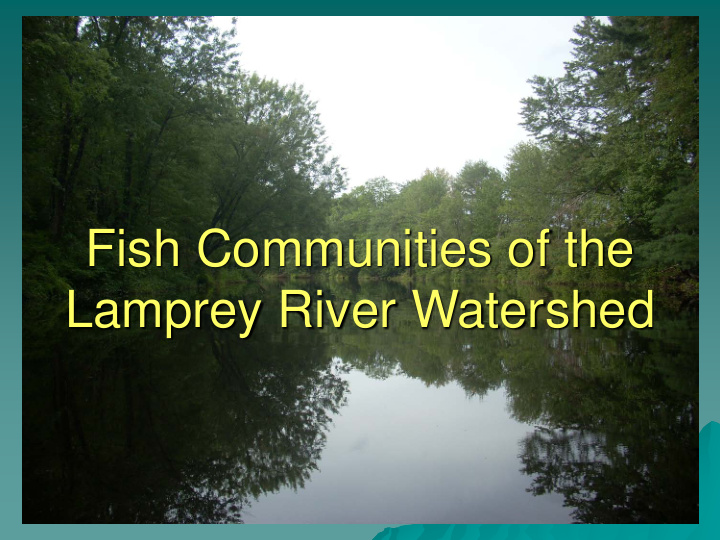



Fish Communities of the Lamprey River Watershed
Objectives Collect information on the status of Eastern Brook Trout in the Lamprey River Watershed and as part of an ongoing project using survey protocols developed for the Eastern Brook Trout Joint Venture. Collect information on the distribution and status of fish species of concern, listed in New Hampshire’s Wildlife Action Plan, and recommend strategies to promote healthy populations and prevent declines of these species. Collect baseline fish community data that will help monitor water and habitat quality throughout the Lamprey River watershed. Identify species that may be used as indicators of healthy water quality and good habitat. Recommend potential conservation strategies that will protect aquatic habitats and promote water quality throughout the Lamprey River watershed.
The Lamprey River watershed can be divided into 9 subwatersheds based on the USGS Hydrologic Unit Code (HUC) system.
Survey Methods Electrofishing surveys were conducted at 105 sites. Sample length was usually 100 meters. All fish species were counted, measured, and weighed. Habitat features and potential impacts were noted at each site. Results 25 different fish species were recorded. A total of 4,226 fish were counted. Fallfish, white suckers, and common shiners were the most widespread and abundant species encountered.
Beaver Dam Golden shiner Old mill dam or road Upper North Branch Common white sucker River
Brown bullhead Unnamed tributary of the Little River Abandoned beaver pond Fallfish
North River looking upstream Longnose dace Cobble/boulder substrate Blacknose dace North River looking upstream Gravel substrate
Pumpkinseed North River Lamprey River in Raymond Chain pickerel
Margined Madtom Common shiner (top) and Fallfish (bottom) Creek chubsucker Yellow Perch
Downstream of dam Lamprey River Mainstem Bunker Pond Dam Smallmouth bass Largemouth bass Redbreast sunfish
Diadromous Fish Species of Concern in the Lamprey River Watershed River herring American eel Sea lamprey
Freshwater Fish Species of Concern in the Lamprey River Watershed Banded Sunfish Swamp Darter Bridle Shiner Redfin Pickerel
Map of SOC Swamp Darter = Red Redfin Pickerel = Green Banded Sunfish = Yellow
Bridle shiners appear to have been extirpated from a number of water bodies where their presence was recorded in the late 1930’s Examples of water bodies where Examples of water bodies where bridle shiners appear to be extirpated bridle shiners are still present Mill Pond (Oyster River) Jones Brook (Middleton) Wheelright Pond (Lee) Exeter River (Fremont) Canobie Lake (Windham) Cocheco River (Farmington) Merrimack River (Boscawen) Lamprey River (Raymond) Heads Pond (Hooksett) Isinglass River (Barrington)
Eastern Brook Trout Joint Venture
Stratified drift aquifers in the Brook trout focus areas Lamprey River Watershed Brook trout depend on spring fed streams in southeastern New Hampshire
Rum Brook
Aunt Mary Brook
Depending on the source of groundwater, spring fed streams can be surprisingly resilient or extremely sensitive habitat. A driveway culvert and excavation within the stream channel resulted in subsurface flow downstream.
A study in Maryland showed that brook trout were not present in watersheds with greater than 4% impervious land cover. A USGS study showed impacts to aquatic invertebrates at impervious surface coverages of between 5 and 10%. Land protection alone Remaining catchments with less than 6% impervious surface coverage (blue) in the cannot prevent declines Lamprey River watershed. Existing in aquatic habitat and conservation land is outlined in green. water quality.
Riparian Zones and Healthy Fish Communities Removing vegetation along waterbodies results in: •Alterations to natural aquatic habitats •Increased water temperature •Increased pollution/sediment introduction rates •Reduction of stream bank stability •A loss of cover for fish and wildlife Riparian buffers should range from 30 m to 300 m depending on the desired level of protection.
Stream Crossing Design
Stormwater Management Disconnecting stormwater runoff from headwater streams will have lasting benefits for aquatic habitats and water quality. UNH Stormwater Center 2005 Data Report shows that low impact development designs (LID) performed better than traditional designs like retention ponds. Porous asphalt reduces runoff and improves groundwater recharge. U.S. Forest Service publication: Environmentally Sensitive Road Maintenance Practices for Dirt and Gravel Roads. Available: http://www.fs.fed.us/eng/pubs/pdf/11771802.pdf
Where to begin? Stream crossing surveys Stormwater outfall surveys Riparian buffer mapping Impervious surfaces (red) and stream crossings (green) in the Lamprey River Watershed
Education and Outreach The Full Lamprey River Fish Survey Report is available on the Lamprey River Advisory Committee (LRAC) website.
Recommend
More recommend